An Introduction by Hermann Karcher and Konrad Polthier
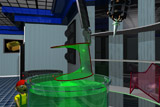 Video with voice and sound (3.6MB,
1.0MB).
Video with voice and sound (3.6MB,
1.0MB). |
A magical fascination arises from colorful soap bubbles flying in the wind. The observer immediately gets attracted while simultaneously trying to watch and touch the beautiful creations as he did in his early childhood. But behind these esthetic shapes lie deep mathematical problems as well as practical applications in architecture, physics and chemistry, which one can discover, in spite of their complexity, in an amusing way with the video Touching Soap Films.
Soap Films in Mathematics
The shape of a bubble is only the simplest example of an incredible wealth of shapes, which arise with soap films. Imagine a simple experiment with soap films in the kitchen: dip a curved metal wire into a mixture of water and washing-up liquid, and, when you cautiously pull it out, a soap films forms. It is incredible but true, this soap film solves an ancient mathematical problem, and it does this job with an amazing elegance and simplicity. Namely the soap film has the least surface area among all surfaces spanned by the wire which one can imagine.
The exact description and the study of surfaces with least surface area and bounded by a given wire was the aim of century-long research of mathematicians up to our time. In the last years it has had a lively renaissance with the help of computer graphics techniques.
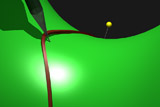 Video with voice and sound (1.7MB,
0.4MB).
Video with voice and sound (1.7MB,
0.4MB). |
To find an optimum belongs to the central problems in many areas of life. Every day we are trying to find the shortest distance or finish projects in the shortest time. The mathematician Lagrange recognized 200 years ago, that the problem of area minimizing is a characteristic standard example and a detailed study of its properties would lead to far-reaching knowledge for many other so-called variational problems. And indeed, this became true. The degree of complexity of the occurring problems outreached the capabilities of the mathematical craftsman's tools of those days and it urged mathematicians of the next generations to develop manifold techniques in different areas of mathematics. Among those were differential geometry, complex analysis, theory of partial differential equations and calculus of variations, to name the major fields.
The importance of the problem can also be measured by the valuable prizes being awarded for partial solutions. The most spectacular prize was the 1936 Fields medal (mathematicians do not receive Nobel prizes) awarded to Jesse Douglas for his life's work, which found its peak in the celebrated solutions of the general soap film problem.
Architecture and Tent Roofs
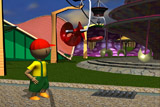 Video with voice and sound (8.6MB,
2.3MB).
Video with voice and sound (8.6MB,
2.3MB). |
Soap films, in mathematics called minimal surfaces, have special properties because of which they are used as models in several different fields. It is most obvious that the least area property was used in architecture for light roof constructions, form finding models for tents, nets and air halls and which led to an autonomous trend in architecture. One of the most spectacular buildings of that architectonic period are the roofs of tents as for example the Munich Olympic stadium and the former Kongreßhalle in Berlin, but also all the smaller tent roofs on pavilions in many parks and public places remind us of that.
In spite of their sometimes immense extension these roofs do not depress but instead invite fantasy with their winged and light shapes. If one ignores gravity then these roofs all have the form of gigantic soap films, which are spanned along the boundary and fixed at certain points. No other roof construction could be constructed with smaller surface area and therefore the amount of material, and with it the roof's weight, is reduced to minimum. Simultaneously, the balanced surface tension stabilizes the whole construction since it is in equilibrium at each point on the soap film.
Crystallographic Models and Zeolithes
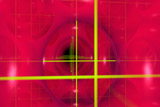 Video with voice and sound (8.6MB,
2.3MB).
Video with voice and sound (8.6MB,
2.3MB). |
Contrary to a soap bubble which encloses under pressure a certain volume of air, a soap film is in equilibrium and has the same pressure on both of its sides. Soap films (without self intersections) divide space therefore into two regions and can be seen as the interface between them. This natural separating property can be observed in a number of physical models: polymer chemists made experiments about the equilibrium state of two mixed long-chained polymers. Different to oil and water which separate one above the other in a clean way, these polymers generate complicated involved structures. Projection photographs with a raster electron microscope revealed a striking similarity with pictures of periodic minimal surfaces and helped for a better understanding of those structures.
Zeolithe crystals consist of a skeleton of silicium, aluminium and oxygen atoms, whose interspace is filled with crystal water. During careful heating the water evaporates and leaves a highly porous crystal skeleton which is used as ion exchanger, as molecular sieve or during oil cracking. It turns out that the tetrahedral building units of sodalith has the form of a minimal surface of Schwarz. Similar connections were found for other zeolithes.
An amazing similarity was found during the investigation of electric fields in crystal grids between minimal surfaces and zero potential fields where point charges are located at the grid points of the crystal. In these studies minimal surfaces seem to play merely the role of prototypes of potential spatial structures. The real world applications usually are more complicated than the clean mathematical models.
Mathematical Visualization
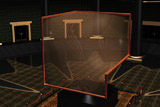 Video with voice and sound (15.4MB,
4.2MB).
Video with voice and sound (15.4MB,
4.2MB). |
Even for mathematicians it is not sufficient to think only in abstract space and answer theoretical questions, they too need intuition for ideas and confirmation of their conjectures through practical experiments. Many questions in minimal surface theory come from experiments with soap films, for example of the famous mathematician Courant and the physicist Plateau. In spite of their success such experiments must be restricted to relatively simple questions because of the lack of stability of soap films.
Like in many other areas computer technology and state of the art visualisation techniques lead to new insight and introduced spectacular break throughs. These new tools enable researchers to works experimentally with perfect artificial soap films in virtual environments. In addition to the technical hardware new methods and techniques in mathematical visualisation are responsible for the enormous development during the recent years. To this belong for example the development of discrete techniques for the description of geometries and their properties as well as methods for visualization and development of software packages as experimental environments.
The Video
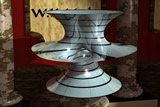 Video with voice and sound (3.6MB, 1.0MB).
Video with voice and sound (3.6MB, 1.0MB).
|
The video Touching Soap Films is a mathematical feature film about the area of soap films. It is completely computer generated including the acting figures. With their approach to explain science in a feature film the production team enters new ground and opens the material to a broader audience in a lively way.
Although the film has a popular scientific character the picture material used arises from recent research and is to a large extent new material even for specialists. Therefore the film contains a second level of understanding which however is accessible only from a student level. It needs a deeper study of the area of minimal surfaces. For the interested reader we recommend the popular scientific literature in the appendix which also contains further references.
Prof. Dr. Hermann Karcher is professor in differential geometry at the University of Bonn and has studied minimal surfaces intensively for the last 10 years.
Dr. Konrad Polthier works in differential geometry at the Technical University of Berlin and belongs to the pioneers in mathematical visualization.
Authors Andreas Arnez, Konrad Polthier,
Martin Steffens, Christian Teitzel
Produced at Sfb 256 at University of Bonn
Sfb 288 at Technical University of Berlin
Year 1995
Speaker (English)
Kalle Leon Hansen
Professor, Computer
and Organ Grinder Erik Hansen
Guard Christoph März
Animation Andreas Arnez
Martin Steffens
Christian Teitzel
Character Design Andreas Arnez
Modeling Martin Steffens
Technical Director Christian Teitzel
Based on a Story by Konrad Polthier
Music and Sound Christoph März
Directed by Konrad Polthier
Studio VTTV Berlin
Software Softimage
Grape (Sfb 256)
Thanks
Bernd Oberknapp, Matthias Heil, Hermann Karcher, Ralf Neubauer, David Oliver, Armin Ortmann Grape Crew, Computergraphic Groups at Sfb 256 und Sfb 288 Institut für leichte Flächentragwerke an der Universität Stuttgart Sonderforschungsbereiche 256 (Univ. Bonn) and 288 (TU-Berlin)
Literature
H. Karcher, K. Polthier Die Geometrie von Minimalflächen Spektrum der Wissenschaft 10 (1990)
Hildebrandt, A. Tromba Panoptimum: Mathematische Grundmuster des Vollkommenen Spektrum der Wissenschaft, Heidelberg 1987
K. Wilhem Architekten heute - Frei Otto Quadriga-Verlag Severin 1985
S. Anderson et. al. Minimal Surfaces and Structures: From Inorganic and Metal Crystals to Cell Membranes and Biopolymers Chemical Reviews 88 (1988)
D. Hoffman Computer-Aided Discovery of New Embedded Minimal Surfaces Mathematical Intelligencer 9 (1987)
Spektrum Videothek Seifenblasen in Wissenschaft und Technik